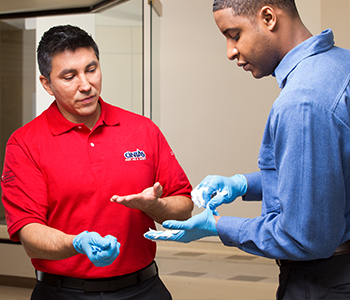What is First Aid Training?

First aid training instructs participants in how to assist a person suffering from a sudden illness or injury until professional medical assistance can be provided. First aid training can help prepare you to quickly respond to many medical emergencies including: internal or external bleeding, eye, mouth and nose injuries, sprains, broken bones, burns, cuts, dehydration and breathing problems.
Industry standards advise at least 2 people per area per shift receive first aid training every two years, with an annual refresher to keep skills sharp[1]. Cintas is one of the largest national providers of American Heart Association (AHA) First Aid, CPR and AED training. Choose from 350+ on-site and online training topics to meet your workplace needs.
First Aid Training Courses
First aid training courses provide the latest skills and techniques for assisting an ill or injured person in the critical moments before emergency medical assistance arrives.
First aid classes can also include CPR and AED training, a technique that can assist someone whose heartbeat or breathing has stopped. CPR stands for cardiopulmonary resuscitation and AED stands for automated external defibrillator. When administered in the first minutes of cardiac arrest, CPR can double or triple the chance of a person’s survival, according to the American Heart Association.
With our nationwide network of Cintas instructors, you can easily schedule training at your location or a local Cintas First Aid & Safety facility. Cintas offers First Aid, CPR/AED classes on-site at your facility, open enrollment classes at a Cintas First Aid & Safety facility, or blended online/on-site training.
Levels of First Aid Training
There are both basic and advanced skills included in first aid training courses to help lessen medical trauma before EMS arrives.
Basic first aid skills train participants how to respond to sudden emergencies including: internal or external bleeding, eye, mouth and nose injuries, sprains, broken bones, burns, fainting and seizure. Through basic first aid training, you will learn how to recognize and respond to medical emergencies, and teaches specific steps for treating injuries.
Advanced first aid skills train participants how to respond to potentially more serious medical events including: heart attack, stroke, asthma, allergic reactions, and seizures, traumatic injuries, serious burns and cuts. Through advanced first aid training, you will learn how to recognize and respond to more serious medical emergencies, and teaches specific steps for treating injuries.
Types of First Aid Training
There several different types of first aid training. These first aid courses can address particular populations, including infants and seniors. Types of first aid training include:
- Workplace first aid courses
- Treat and respond to workplace injuries like burns or heart attack
- Emergency first aid training
- Respond to illnesses and injuries in any emergency situation at home or in public spaces
- Pediatric first aid courses
- Respond and manage illnesses and injuries in small children like allergies and cuts
- Senior first aid training courses
- Respond and treat injuries more common in senior population including falls and stroke
Medical Emergencies – First Aid Topics
First aid training courses cover a wide variety of medical topics, and instruct participants on best practices in treating emergency medical events quickly. First Aid topics include:
- Cardiac arrest
- Heart attack
- Stroke
- Seizures
- Low blood sugar
- Allergic reactions
- Injuries
- Internal, external bleeding
- Eye, mouth, nose injuries
- Sprains
- Broken bones
- Burns
- Cuts
- Fevers
- Skin problems
- Body Pain
- Wound care
- Traumatic injuries
[1] https://ohsonline.com/Articles/2018/04/01/Meeting-OSHAs-First-Aid-Requirements.aspx